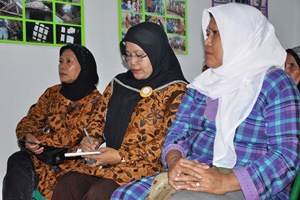Indonesia: Housewives help fight TB
Housewives in Cicendo District near Bandung in West Java, Indonesia’s third largest city, are spearheading the fight against tuberculosis (TB) by helping to identify people suspected of having contracted the disease and then referring them to a clinic for treatment.
Activists trained by Aisyiah, the women’s wing of
Muhammadiyah, a Muslim organization, work with religious as well
as neighbourhood leaders to educate people about TB, and recruit
family members to monitor patients’ adherence to their
medication. People with TB often experience social stigma and
many Indonesians see TB as a disease of the poor.
“One of our problems is that people here are ashamed to
admit that they have TB,” said Nunung Resmawati, one of
the “community cadres” in Cicendo District.
“So we talk to them and try to convince them TB is not a
curse, and not something to be ashamed of. It’s a serious
disease but one that can be cured.”
Aisyiah says it has trained more than 4,800 people in 18 of the
country’s 33 provinces in 41 districts since its Community
TB Care programme started in 2009, with assistance from the
Global Fund to Fight AIDS, Tuberculosis and Malaria. So far its
cadres have identified more than 24,000 suspected cases, about
3,000 of whom were confirmed to have contracted the disease.
The UN World Health Organization (WHO) notes that about
one-third of the global population is infected with TB bacteria,
but only a small proportion will become sick, yet it is still
one of the world’s top killer infectious diseases. About
95 percent of TB deaths occur in low- and middle-income
countries. It is also one of the three main causes of death
among women aged 15 to 44.
With a population of about 240 million, Indonesia has the fourth
highest TB burden globally, WHO reported in
2012. In 2010 the estimated prevalence per 100 000 people for all
forms of TB was 289, with an incidence of 189 cases. According
to the Ministry of Health, some 61,000 deaths a year occur as a
result of TB.
Many people are still not aware that to be cured, a TB patient
must strictly follow a treatment regimen and complete the full
course of medicine as prescribed. The strategy recommended by
WHO for the detection and cure of TB is the Directly Observed
Treatment Short course (DOTS).
But it's not just women that Aisyiah is involving in their
efforts. Men are also getting involved.
“I supervised my sister-in-law to take TB drugs regularly
and thank God she’s cured now,” said Ridwan, who
like many Indonesians goes by only one name. “When she was
sick with TB she was pregnant, but she managed to give birth to
a healthy baby,” he told IRIN.
Close to 5,000 women are getting the word outIndonesia reduced
new TB cases from 343 per 100,000 people in 1990 to 235 in 2009,
according to the Health Ministry. However, under its national TB
strategy 2010-2014, the goal is to lower the number of new cases
to 224 by 2014.
The case detection rate has improved from 20 percent in 2000 to
73.1 percent in 2009, and the country aims to increase the
number of TB patients cured by using DOTS from 85 percent to 88
percent by 2014.
TB remains a major health threat in the Indonesian capital,
Jakarta, said Erlina Burhan, chief pulmonologist at Persahabatan
Hospital, the country’s main referral centre for TB
patients.
“In Jakarta the new case finding rate is already high - at
above 72 percent - but some of them did not complete their
treatment. They could easily infect others,” Burhan said.
Health experts believe around 2 percent of new TB cases in
Indonesia are multidrug-resistant (MDR) TB, and that up to 20
percent of people who undergo treatment for recurring TB are
suffering from MDR-TB.
However, these data are mainly from DOTS centres. According to
WHO, information from the private sector and the non-national TB
programme public sector has not yet been recorded by the
country’s TB programme, so there are no nationwide
statistics on the prevalence of MDR-TB.
MDR-TB occurs when a strain of Mycobacterium tuberculosis, which
causes the disease, becomes resistant to isoniazid and rifampin,
two of the most powerful first-line drugs. Burhan said MDR-TB
patients must take a combination of second-line drugs, which may
have more side effects. The treatment typically lasts two years
and costs more than for non-resistant TB.
Persahabatan Hospital receives about 1,000 TB patients from
Jakarta and neighbouring suburbs every year, and has treated 270
people with MDR-TB since 2009, 40 of whom have completed
treatment, while the while the rest are still receiving therapy.
“Some of the patients stopped taking drugs after two
months because they felt well and didn’t realize they
could get MDR-TB,” Burhan said. “It hard to convince
patients to complete treatment.”
IRIN
http://www.irinnews.org/Report/95632/INDONESIA-Housewives-help-fight-TB


